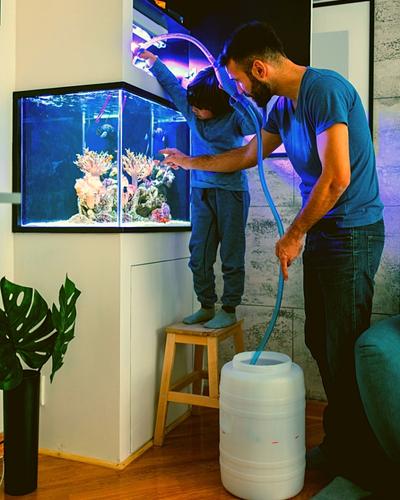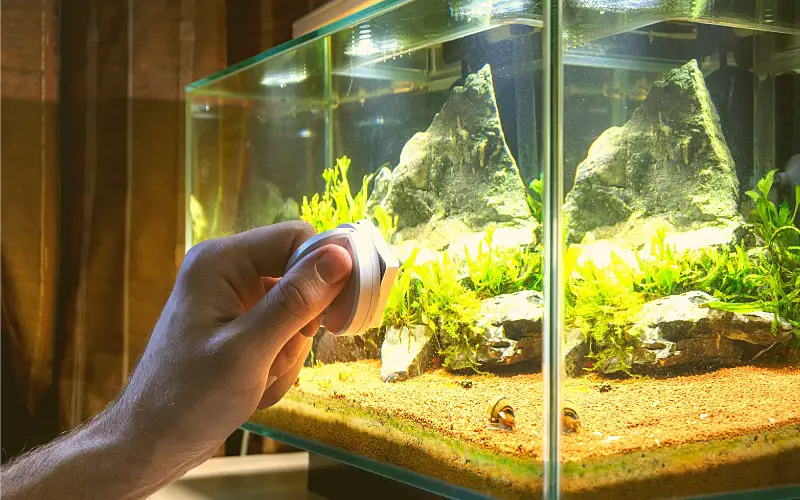How often to clean betta fish tank? Betta fish, or Siamese fighting fish, are famous pets due to their vibrant colors and unique personalities. Keeping a clean and well-maintained tank is essential for the health and well-being of these beautiful creatures. But how often should you clean your Betta fish tank?
This essential guide will provide all the information you need to ensure your Betta fish have a clean and healthy environment to thrive in.
Proper tank maintenance is crucial for ensuring the optimal health and happiness of your Betta fish.

Neglecting to clean the tank regularly can lead to a buildup of harmful toxins and bacteria, harming your fish’s health. However, cleaning the tank too frequently can also disrupt the delicate balance of the aquarium’s ecosystem.
In this Comprehensive guide, we will cover the key factors to consider when determining how often to clean your Betta fish tank, including tank size, filtration system, and water quality.
By following the advice in this essential guide, you can ensure that your Betta fish have a clean and healthy environment.
Table of Contents
ToggleHow Often to Clean Betta Fish Tank?
How often clean betta tank? It is recommended to clean a betta fish tank at least once a week. This involves removing 25-50% of the water and replacing it with fresh, dechlorinated water.
It’s essential also to vacuum the gravel and remove any uneaten food or waste from the bottom of the tank.
Scrubbing the tank’s walls with a sponge or algae scraper can help remove any algae buildup or other debris. It’s also a good idea to clean the filter regularly to ensure it is functioning correctly and not clogged with debris.

A thorough tank cleaning should be done every 2-4 weeks, where all décor, gravel, and the sides of the tank are cleaned to remove any built-up waste and algae.
Keeping the tank clean is essential for the health and well-being of the betta fish, as it helps prevent the buildup of harmful ammonia and bacteria that can be detrimental to their health.
How Long Does It Take to Clean a Betta Fish Aquarium?
The time it takes to clean a betta fish aquarium can vary depending on several factors, so there’s no one-size-fits-all answer. Here’s a breakdown of what influences the cleaning time:
Factors influencing cleaning time:
- Tank size and complexity: A smaller tank with few decorations will be quicker to clean than a large, heavily decorated one.
- Cleaning depth: A simple spot clean to remove debris and do a small water change will take less time than a complete deep clean with gravel vacuuming, filter maintenance, and decoration scrubbing.
- Experience level: Experienced aquarists can often clean a tank faster than beginners.
- Tools and equipment: The right tools, like a gravel siphon and water conditioner, can expedite the process.
Estimated cleaning times:
- Essential water change and spot clean: 15-30 minutes.
- Moderate clean with gravel vacuuming and decoration rinsing: 30-60 minutes.
- Deep clean with filter maintenance and substrate replacement: 1-2 hours.
Here are some additional tips for a faster clean:
- Do it regularly: Regular cleaning prevents buildup and makes deep cleaning less necessary.
- Keep accessories simple: Opt for smooth ornaments and plants that are easy to clean.
- Prepare beforehand: Gather all your supplies before starting.
- Multitask: While the water conditioner works, clean decorations or the filter.
Remember: These are just estimates, and your cleaning time may vary. Focus on maintaining a healthy environment for your betta fish and adjust your cleaning routine based on your setup and experience.
What Tools Will You Need To Clean The Betta Fish Tank?
You will need some essential tools to clean a betta fish tank properly. First and foremost, a good quality aquarium gravel vacuum is necessary for removing debris and waste from the bottom of the tank.
A sponge or algae scraper will also be required to clean the tank’s walls and decorations. A bucket or water siphon is needed to remove and replace water from the tank.
Additionally, a water conditioner is essential for treating the new water that will be added to the tank to make it safe for the fish.
Finally, having a clean, dedicated sponge or cloth for wiping down the outside of the tank is vital to keep it looking its best. With these tools, you can ensure your betta fish tank stays clean and safe for your finned friend.
Here are the essential tools you will need to clean a betta fish tank:
- Gravel vacuum or siphon: This removes dirt, debris, and uneaten food from the gravel at the bottom of the tank. A siphon is a long, flexible hose that you can use to suck up the gravel and water. A gravel vacuum has a gravel guard that helps prevent you from sucking up the gravel itself.
- Bucket: You will need a bucket to hold the water you remove from the tank during a water change.
- Algae scraper: This is used to remove algae from the sides and walls of the tank. Many different types of algae scrapers are available, so choose one appropriate for the kind of algae you have in your tank.
- Water conditioner: This removes chlorine and chloramines from the water you add to the tank. Chlorine and chloramines harm fish, so using a water conditioner when adding new water to the tank is essential.
- Test kit: A test kit is used to test the water quality in your tank. This is important because it will help you ensure the water conditions are healthy for your fish.
- Net: A net removes fish from the tank when you need maintenance, such as cleaning the gravel or adding new plants.
- Soft sponge or cloth: A soft sponge or cloth can be used to wipe down the sides and walls of the tank.
In addition to these essential tools, there are a few other things that you may find helpful:
- Thermometer: A thermometer measures the temperature of the water in your tank. Keeping the water temperature within the optimal range for your betta fish is essential.
- Hydrometer (optional): A hydrometer measures the specific gravity of the water in your tank. This is optional, but it can be helpful if you are keeping brackish water fish.
How To Clean Your Betta Fish Aquarium Step-By-Step
Keeping your betta fish aquarium clean is essential for your friend’s health and happiness. Here’s a step-by-step guide to help you out:
Gather your supplies:
- Bucket
- Siphon (gravel vacuum)
- Soft sponge or cloth
- Algae scraper
- Water conditioner
- Thermometer
- Towel
Prepare To Clean Your Betta Fish Tank:
- Wash your hands: This is important to prevent the introduction of harmful bacteria into your fish’s tank.
- Test the water: Before cleaning, test the water for ammonia, nitrite, and nitrate levels. These should all be at zero. If not, you may need to prepare for a larger water change.
- Turn off the filter and heater: This will prevent them from being damaged during cleaning.
Cleaning the tank: Scrub the inside with a new sponge or cloth
- Remove the decorations and plants: Carefully remove them from the tank and place them in a bucket of clean water. You can gently rinse them with warm water to remove algae or debris.
- Partial water change: siphon 25-50% of the water from the tank. Be careful not to vacuum up your betta fish!
- Gravel cleaning: Use your siphon to vacuum the gravel. This will remove any food debris, fish waste, and other organic matter that has built up.
- Clean the tank walls: Use a soft sponge or cloth to wipe down the tank walls gently. You can use an algae scraper to remove any stubborn algae spots.
- Clean the decorations and plants: If necessary, use a soft brush to remove any algae or debris from the decorations and plants. Rinse them thoroughly with clean water before returning them to the tank.
Clean The Filter
After removing the filter, it’s time to clean it well. Start by inspecting it for any visible dirt or debris. Use a brush or cloth to loosen and remove any buildup collected on the filter.
For a more thorough clean, you should soak the filter in a water and vinegar solution to help break it down and remove any stubborn residue.
Once the filter is clean, rinse it thoroughly with clean water and allow it to dry completely before reinserting it into the appliance. Clean filters, such as vacuum cleaners, air purifiers, and pool filters, are essential for the proper functioning of appliances.
Neglecting to clean the filter regularly can lead to reduced efficiency and potentially costly repairs. By incorporating regular filter cleaning into your maintenance routine, you can prolong the lifespan of your appliances and ensure they continue to operate effectively.
Refilling the tank:
- Fill the tank with fresh, temperature-matched water. Treat the water with a water conditioner to remove chlorine and chloramines.
- Turn on the filter and heater.
- Check the water temperature: Ensure the water temperature is within the optimal range for your betta fish (78-82°F).
- Return the decorations and plants to the tank. Arrange them in a way that your betta fish will enjoy.
- Return your betta fish to the tank.
Additional tips:
- Do not clean the tank with soap or detergents, as these can harm your fish.
- If you have live plants in your tank, you may need to trim them occasionally.
- It is a good idea to clean your betta fish aquarium once every week or two.
Here are some additional things to keep in mind:
- The frequency of cleaning will depend on the size of your tank, the number of fish you have, and the type of filtration you are using.
- If your tank is heavily stocked or you have a lot of algae growth, you may need to clean it more often.
- Be careful not to overclean your tank, which can remove beneficial bacteria.
By following these steps, you can keep your betta fish aquarium clean and healthy, providing your finned friend with a happy and thriving home.
Should You Clean The Filter At The Same Time As The Aquarium?
Yes, it is recommended that you clean the filter at the same time you clean the aquarium. The filter is a vital component in maintaining a healthy aquatic environment for your fish, as it helps to remove waste and impurities from the water.
Over time, the filter can become clogged with debris, reducing its effectiveness and potentially causing harm to your fish. By cleaning the filter regularly, you can ensure that it continues to work efficiently and provide a clean and safe habitat for your aquatic pets.
Additionally, performing both tasks simultaneously can help to minimize any disruption to the natural balance of the aquarium. However, following the manufacturer’s instructions for cleaning the filter is crucial, as different filters may require additional maintenance routines.
Overall, regular maintenance of both the aquarium and the filter will help promote your fish’s well-being and maintain a beautiful aquatic environment.
How To Clean a Betta Fish Tank Without a Siphon?
How to clean betta fish tank without siphon? Cleaning a betta fish tank without a siphon can be done using simple steps. First, remove your betta fish from the tank and place them in a separate container with some tank water.
Next, carefully pour out most of the tank water, leaving just enough to cover the gravel and decorations.
Then, use a fish net or a small cup to scoop out the remaining debris and waste from the gravel and decorations. After that, use a clean, damp cloth to wipe down the inside of the tank, removing any algae or residue.
Finally, add fresh, conditioned water to the tank and carefully reintroduce your betta fish. It’s essential to perform regular water changes, at least once a week, to ensure a clean and healthy environment for your betta fish.
While using a siphon can make the process easier, it is possible to maintain a clean betta fish tank without one by following these steps.
What Are Easy Ways To Keep Your Bettas Tank Clean?
Keeping your betta’s tank clean doesn’t have to be a chore! Here are some easy ways to maintain a healthy and happy environment for your finned friend:
Regular water changes:
- This is the most critical thing you can do. Aim for 25% water changes weekly, using a siphon to remove gravel debris and old water.
- Treat new tap water with a dechlorinator to remove harmful chemicals.
- Wait to do entire water changes too often, as this can disrupt the beneficial bacteria in your tank.
Invest in a good filter:
- A reliable filter will help break down fish waste and keep the water circulating. Choose one rated for your tank size and clean it according to the manufacturer’s instructions.
Live plants are your friends:
- Plants help absorb nutrients and oxygenate the water, reducing algae growth and improving water quality. Choose easy-care plants like Java moss, Anubias, or Amazon swords.
Feed responsibly:
- Overfeeding can lead to excess waste and algae growth. Stick to a feeding schedule and only give your betta enough food to consume in a few minutes.
Decorations and substrate:
- Choose smooth decorations that are easy to clean and avoid overcrowding the tank.
- Rinse gravel or substrate regularly to prevent debris buildup.
Bonus tips:
- Avoid placing your tank in direct sunlight, which can encourage algae growth.
- Test your water parameters regularly for pH, ammonia, and nitrite. This will help you identify potential problems before they become serious.
- Consider adding aquarium snails or shrimp to help control algae naturally.
Following these simple tips, you can easily keep your betta’s tank clean and provide your aquatic friend with a thriving environment. Remember, a clean tank is a happy and healthy betta!
What Happens When You Don’t Clean Your Aquarium?
When you don’t clean your aquarium, several problems can arise. First and foremost, the water quality in the tank will deteriorate, leading to health issues for your fish and other aquatic creatures.
Excess food, waste, and decaying plants can create a buildup of ammonia and nitrites, which can be toxic to your fish.
Additionally, algae and other unsightly growths can take over the tank, making it look unattractive and disrupting the balance of the ecosystem. Regular cleaning is necessary for the filter to avoid becoming clogged, leading to poor circulation and adequate oxygen levels in the water.
Overall, neglecting to clean your aquarium can result in a stressful and unhealthy environment for your aquatic pets, leading to potential illness or even death for the tank’s inhabitants. Therefore, it’s crucial to maintain a regular cleaning schedule to ensure the well-being of your aquarium’s inhabitants.
How do you care for a Betta in a Bowl?
While keeping a betta fish in a bowl is possible, it’s essential to understand that fish bowls are not ideal for long-term health and well-being. Bettas are active fish that require more space and stimulation than a bowl can provide. However, if you’re set on keeping your betta in a bowl, here are some tips on how to care for it:
Bowl size: Choose the largest bowl you can comfortably accommodate. A minimum of 2.5 gallons is recommended, but 5 gallons or more is ideal.
Water quality:
- Use treated tap water or spring water. Never use untreated tap water, as it can contain chlorine and chloramines, which are harmful to fish.
- Maintain a stable water temperature of 75-80°F (24-27°C). Use a thermometer to monitor the temperature and adjust it with a heater if necessary.
- Perform regular water changes of 25-50% of the water every week. Use a siphon to remove gravel debris and waste.
- Do not overcrowd the bowl with decorations. Live plants are beneficial as they help oxygenate the water, but choose plant varieties suitable for bettas and ensure they don’t have sharp edges.
Environment:
- Provide hiding places for your betta, such as caves or plants.
- Avoid placing the bowl in direct sunlight, which will raise the water temperature and promote algae growth.
- Do not tap on the glass or move around the bowl; this can stress your betta.
Feeding:
- Feed your betta a high-quality pellet or flake food formulated explicitly for bettas. Avoid overfeeding, and feed only two or three times a day.
Remember: Even with the best care, bettas in bowls will likely have a shorter lifespan than those in adequately setup aquariums. Consider upgrading your betta to a larger tank (at least 5 gallons) with a filter and heater to provide a healthier and more stimulating environment.
How often do you clean the bowl?
To maintain water quality and the health of your betta fish, clean the betta fish bowl once a week. Perform a partial water change (around 25-50%) and remove debris or waste. Regular cleaning helps prevent the buildup of harmful substances in the bowl.
Commonly Asked Questions about How Often Do You Clean a Betta Fish Tank (FAQs)
How often you need to clean your betta tank?
How often do you clean a betta tank? You should clean your tank every week to maintain water quality and ensure the health of your fish. Regular cleaning helps remove waste and prevent the buildup of harmful substances.
How long does it take to clean a betta aquarium?
The time to clean a betta aquarium water depends on size, setup, and desired thoroughness. Small, essential tanks can take 15-30 minutes, while more significant, intricate ones might need 45-60 minutes. Remember, consistency is vital – shorter, regular cleanings are better than infrequent deep dives!
How often should you clean a betta fish tank?
How often to clean a betta fish tank? Clean your fish tank every week or twice a month. Regular water changes, debris removal, and filter maintenance help maintain a healthy environment, ensuring your betta thrives in a clean tank.
Should you remove your fish from the tank while cleaning it?
It is recommended to remove your lovely tropical fish from the tank while cleaning it. This is to ensure their safety and prevent stress. Preparing clean, dechlorinated water in advance would be best to minimize the time your fish spends in dirty water.
How often should I clean my 2.5-gallon betta tank?
You should clean your 2.5-gallon betta tank every week. This regular cleaning routine helps maintain water quality and the health of your fish. Make sure to have prepared water ready for the cleaning process.
My Aquarium is Complex! How Do I Clean it Without Removing Everything?
To clean a complex aquarium without removing everything, use a siphon or gravel vacuum to remove debris from the substrate. Use an algae scraper or magnetic brush to clean the walls. Replace the water with treated water, and clean or replace the filter media as needed.
How to do a thorough aquarium clean?
To do a thorough aquarium clean, remove decorations and plants, then siphon 25-50% of the water. Scrub the walls and gravel, clean the filter, and replace or rinse the filter media. Refill the tank with treated water and reassemble the aquarium.
How often do you clean a betta fish tank without a filter?
How often should you clean a betta tank without filtering? Without a filter, you should clean your betta fish tank more frequently. Aim to clean it every 2-3 days to maintain water quality. Regular water changes (around 25-50%) are crucial to remove waste and prevent the buildup of harmful substances in the tank.
How often to clean betta fish tank with filter?
Filtered betta tanks need weekly 10-20% water changes and full cleans every 4-8 weeks. Monitor water clarity, fish behavior, and nitrate levels to fine-tune the schedule. Less frequent cleanings may be possible in heavily planted tanks. Prioritize consistency for a happy betta!
Conclusion
So, how often to clean betta fish tank? In conclusion, the frequency of cleaning a betta fish tank depends on several factors, such as tank size, the number of fish, and the filtration system. Generally, partial water changes of around 25-30% should be conducted every 1-2 weeks. The tank should also be thoroughly cleaned every month, which includes removing decorations and vacuuming the substrate. Monitoring water parameters such as ammonia, nitrite, and nitrate levels regularly is essential to determine if the tank needs cleaning more frequently.
Overfeeding or the presence of excess waste can also necessitate more frequent cleanings. Ensuring a clean and well-maintained tank will contribute to your betta fish’s overall health and well-being. Following a regular cleaning schedule can create a thriving and comfortable environment for your betta fish to live in.
You might also like
- My Betta Fish Won’t Eat and Barely Moves: Solved & Explained
- How to Tell If Your Betta Fish Is Happy: (7 Telltale Signs)
- Choosing the Best Betta Fish Tankmates: (The Ultimate Guide)
- Feeding Betta Fish on Vacation: (Best Practices & Tips)
- 10 Best Plants for Betta Fish Tank: (A Comprehensive Guide)





